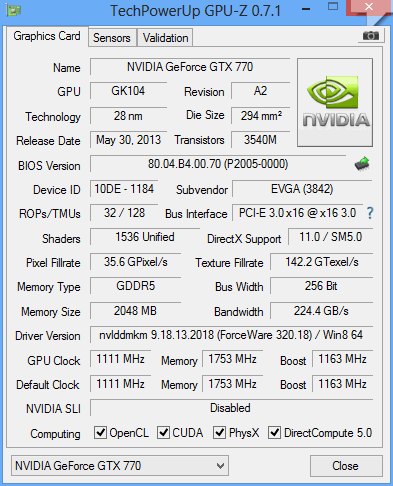Index
- EVGA GTX 770 Superclocked ACX 2GB reviewed
- The Packaging
- A closer look at the ACX cooler
- A closer look at GTX 770 SC ACX continued
- Testbed
- 3DMark
- Hitman Absolution
- Sleeping Dogs
- Tomb Raider
- Dirt Showdown
- BioShock Infinite
- Tessellation - Heaven
- Thermals and Noise
- Overclocking
- Consumption
- Conclusion
- All Pages

Review: ACX pushes it over the top
After EVGA successfully rolled out the GTX 780 Superclocked with the ACX cooler, two new ACX coolers entered the fray, on the GTX 770 and GTX 760. Today we’ll take a look at one of them, the GTX 770 Superclocked ACX.
Based on the GTX 770 design paired up with a custom cooling solution, the new EVGA GTX 770 Superclocked ACX graphics card is factory overclocked, as the name implies. The base clock is set at 1111MHz, while the reference GPU base clock is 1046MHz. Additionally, Nvidia's GPU Boost 2.0 on average ups the GPU clock to 1085MHz for the reference GPU, while the Boost clock for the Superclocked card is 1163MHz.
Since the GTX 770 appears to have hit the price/performance sweet spot for many hard core gamers, EVGA came up with no fewer than ten different SKUs – and who could blame them? Nvidia also made it possible for partners to come up with custom cards with 4GB of GDDR5 memory. Our review sample the GTX 770 Superclocked ACX features 2GB of GDDR5 memory on a 256-bit memory interface and clocked at reference 7010MHz (GDDR5 effective).
For the first time we see Nvidia going for such fast memory modules, which should go a long way towards boosting performance. The peak memory bandwidth stands at 224.3GB/sec – that’s 15 percent more bandwidth than last year’s Geforce GTX 680.
The GTX 770 is based on the GK104 GPU. We already had a chance to meet it last year, in the GTX 680. Both cards have 1536 CUDA cores, 128 texture units and 32 ROPs so the “new” generation doesn’t really bring a lot of new stuff to talk about. As we said, the GTX 680 has slower memory (6008MHz effective GDDR5) and its GPU clock is 1006GHz, while the boost clock is 1058MHz. However the GTX 770 can draw as much as 230W of power, whereas the GTX 680 needs just 195W.
Judging by the specs, it is obvious that the performance difference can’t be very big and but we’re hoping that the factory overclock of the GTX 770 Superclocked ACX will make the difference more visible.



